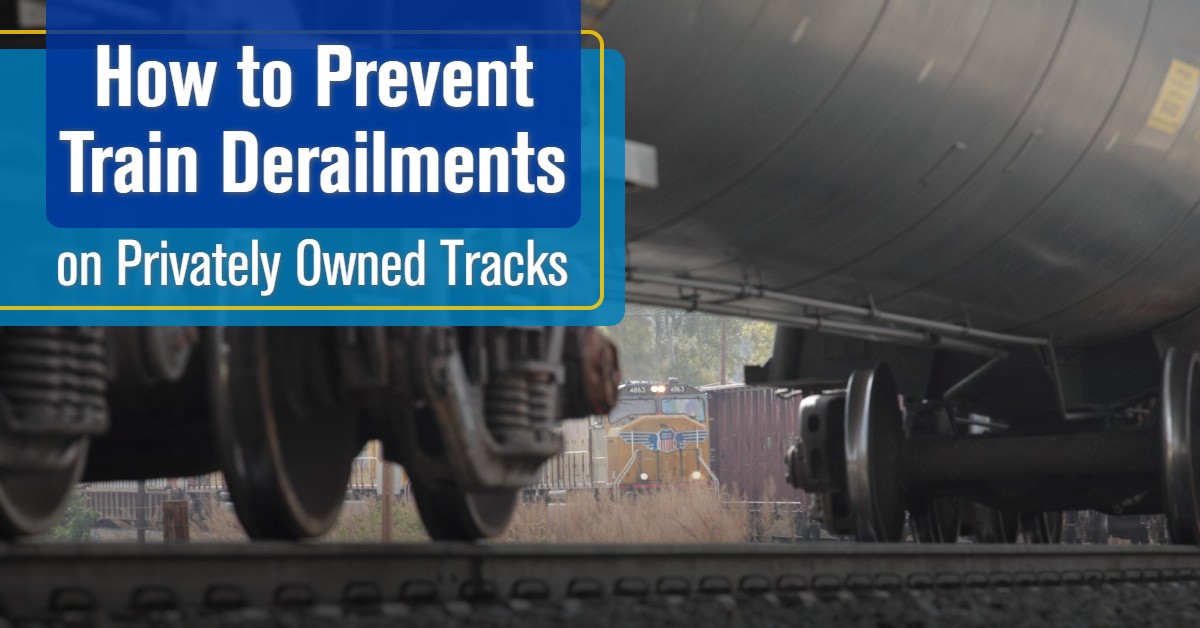If your company has railroad tracks outside its doors, taking care of those privately owned tracks is important. Why? First and foremost, it helps keep your employees, railroad crews and your property safe. But preventing derailments also ensures trains can serve your facility, whether dropping off inbound product or picking up outbound shipments. When your tracks are in good condition, it means that piece of your supply chain is in good condition, too.
Understanding what causes derailments on industry tracks and how to prevent them is an important part of keeping your supply chain moving. Here are the top five causes and the steps you can take to prevent them.
What Are the Top Causes of Industry Derailments?
The top five causes of derailments on privately owned tracks include:
- Wide gauge — “Track gauge” refers to the spacing between rails. The standard measurement of this distance is 56.5 inches. When rails are farther apart than this standard measure, it’s known as “wide gauge.” Wide gauge can be caused by weak rail ties, the back-and-forth movement of rail cars on tracks, worn rail, and defective or missing ties and/or spikes.
- Worn, defective or broken switch points — When one railroad track diverges into two different tracks, movable rails called switches guide the train to the appropriate track. Switch points are the sites at which the track moves, and if these areas aren’t working properly, it can send trains off the tracks.
- Defective or missing ties — Railroad ties are wooden or concrete beams that are laid under the rails perpendicular to the track to support it. When they are loose or missing, the rails can move and cause derailments.
- Clogged flangeways — Flangeways are the spaces through which wheel flanges (the edge on the outside of the rail car wheel that keeps the wheel on a rail) travel. When they are clogged, wheels can rise above the tracks, causing derailments.
- Defective or missing spikes or other rail fasteners — Rail spikes work like giant nails and are driven through base plates to secure the rail to ties. When these are defective or missing, it can cause rail to shift.
What Steps Can You Take to Prevent Derailments at Your Facility?
Derailments on private tracks can happen. The good news is companies can take these simple steps to prevent them.
- Inspect Track Regularly
To ensure track is in good working order:
- Inspect all of the track at your facility regularly — at least on a quarterly basis.
- Use a qualified third-party inspection company contractor to perform inspections.
- Perform maintenance on rail infrastructure on a consistent basis.
- Train your employees to keep an eye out for potential hazards or defects.
- Look for Wide Gauge Tracks
To inspect your track for wide gauge, follow these steps:
- Check for loose or missing bolts and joint bars (also known as “fish plates,” joint bars are the metal bars that are bolted to the ends of two rails to join them together).
- Inspect track for broken railroad ties, loose or missing spikes, and tie plates cutting into the railroad ties.
- Look for mud on top of ballast (the rocks packed between, below, and around the ties that keeps them in place), which may indicate a weak foundation and inadequate drainage.
- Check for broken switch points, which may create a gap between the rail and point, allowing the wheel of a rail car to travel down the wrong track.
- Keep an eye out for diminished structural integrity, like poor tie conditions or spike quantity, which may also result in buckled or rolled rail.
- Bonus: Install Clearance Cone Markers
While not among the top 5 causes, another simple way to prevent derailments within your facility is to prevent sideswipes, which happen when rail cars are left beyond clearance points and switch crews are unaware the track is obstructed.
Preventing sideswipes is easy: Simply place brightly colored traffic cones where cars can be safely spotted without obstructing an adjacent track. Painting two railroad ties 15 feet back along the cones can also help make it easy to identify where cars can be spotted safely.
Learn More
To learn more about keeping tracks safe and operational at your facility, we recommend contacting a third-party track maintenance contractor for track inspection and maintenance support.
To download a printer friendly version of these guidelines, click here.
Related Articles









